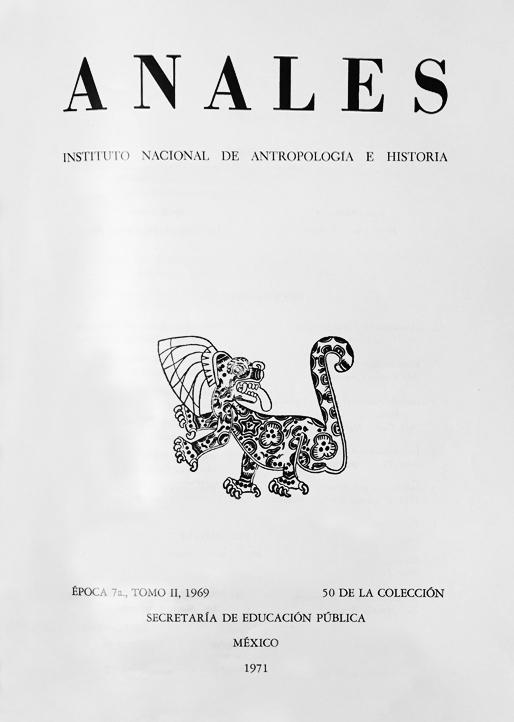Arqueología
Comentarios sobre la Coatlicue recuperada durante las excavaciones realizadas para la construcción del Metro.
Publicado 1971-02-02
Palabras clave
- Arqueología,
- Mitología,
- Personajes,
- Coatlicue,
- Religión
Cómo citar
Comentarios sobre la Coatlicue recuperada durante las excavaciones realizadas para la construcción del Metro. (1971). Anales Del Instituto Nacional De Antropología E Historia, 7(2), 153-170. https://revistas.inah.gob.mx/index.php/anales/article/view/7282
Resumen
This sculpture (plates I-V) was discovered in September, 1967, during excavations carried out in Mexico City's "Metro". Its total height is 93 cm., its length 57 cm., width 37, and weight approximately 530 k. Today it is on display in the Mexica Hall of the National Museum of Anthropology, where it is called Coatlicue.Coatlicue (also called Toci and by many other names) was the Mother Goddess, having given birth to the Sun, the Moon, the Stars, and all the other gods. She was also associated with the earth, fertility, life, and death. This statue is covered with a wealth of symbols.
The face is that of Tlaltecuhtli, earth deity, as seen in plate VI. In different sources Tlaltecuhtli is referred to as female or as male, the latter in the form of a toad-like monster. This monster is carved on the base of the monumental Coatlicue and is seen in the Codex Borbonicus 16 (fig. 1). In the Codex Borgia 34 (fig. 2) Tlaltecuhtli is represented as an old woman with wrinkles around her mouth. The lines on the statue's face represent both these wrinkles and facial paint: Xochiquetzal (the young Mother Goddess, therefore Coatlicue) wears red paint on the Iower part of her face (fig. 3). The bisexual character of the earth deity indicares a duality characteristic of creative gods.
The figure's half-closed eyes. are like those of Coyolxauhqui, Moon Goddess, and indicate death. The tongue in the form of a knife with a claw and eye is not only associated with the earth and with sacrifice but also is the tongue of the sun in the Sun Stone (fig. 4). Coatlicue was the mother of the Sun in the form of Huitzilopochtli, solar god associated with war.
Another element of sacrifice and death may be seen in the feather balls in the goddess's hair. Is it possible that these elements refer to the death of the deity in her representation of the earth, that is, the death or end of a Sun or cosmogonic period?
The hands are both claws and serpent heads. The eyes and fangs seen on the elbows and shoulders again refer to the earth monster. The necklace of four hands and four hearts is the same as that worn by the monumental Coatlicue, with the difference that the central pendant here is a fifth heart and not a skull. The elements of four undoubtedly refer to the cardinal directions and the heart pendant to the center of the earth.
While Coatlicue' s tired breasts are seen in her monumental statue and in others that are exhibited in the Mexica Hall, there is no evidence of them in our "Metro" sculpture. This fact, combined with the position of the legs (a position strictly masculine, as may be seen in plate VIII, the god Xochipilli; Mexica goddesses are always represented in a kneeling position like plate VII), leads us to believe that the deity represented is really masculine. The necklace of hands and hearts has served to identify the figure as Coatlicue, but in the monthly feast of Huey Pachtli the priests' costumes were decorated with these two elements. The associated feast of Pachtlontli, in honor of Xochiquetzal, commemorated the birth of Huitzilopochtli. During Huey Pachtli, Iztaccihuatl was honored; this was but another name for Coatlicue-Xochiquetzal. The use of the hands and hearts at this time shows a direct relationship with Huitzilopochtli.
Caso has indicated that the skulls and cross bones represent the skirt of the Earth Goddess, as seen in Codex Borgia 44 (fig. 5). This is the short skirt worn by our deity.
We feel that the "Coatlicue del Metro" is a figure dedicated to the Earth. It also seems to be a profound expression of duality, as it is male and female, mother (Coatlicue) and son (Huitzilopochtli), Sun and Moon, life and death, fat years and lean (symbolized by the open hands and hearts and the "twisted" skirt of Coatlicue, according to Durán). The many duality characteristics suggest a conclusion that is daring but not impossible: because of the elements of creation present this statue could represent Ometeotl, the divine creative pair.

